Lightweight Insulating Concrete
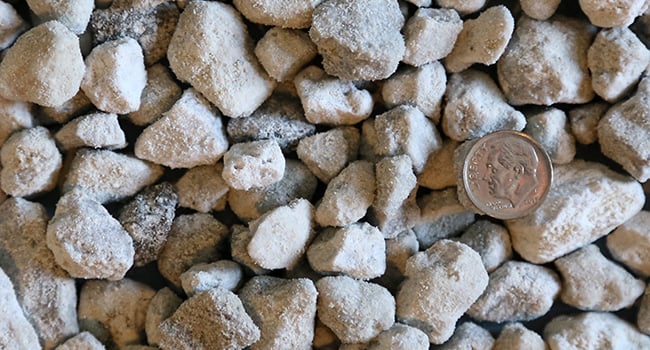
ABOVE: Standard pumice concrete aggregate (Hess Grade 3/4 x 5/16MN). BELOW: Standard pumice concrete sand (Hess Grade 1/8 Fines MN). The MN designation is for “mine grade.” Mine grades are ideal for concrete aggregate because they are 1) economical—minimally processed and sold in bulk (by the ton), and 2) naturally contain some moisture.
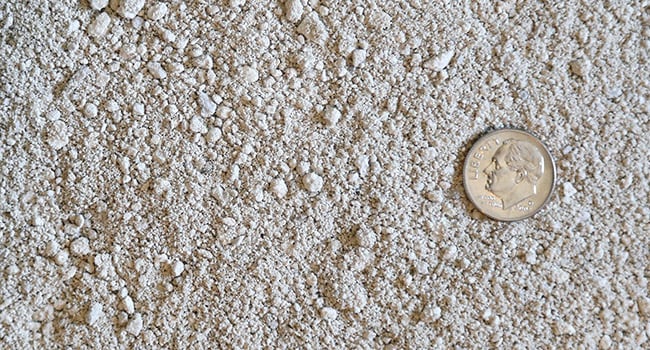
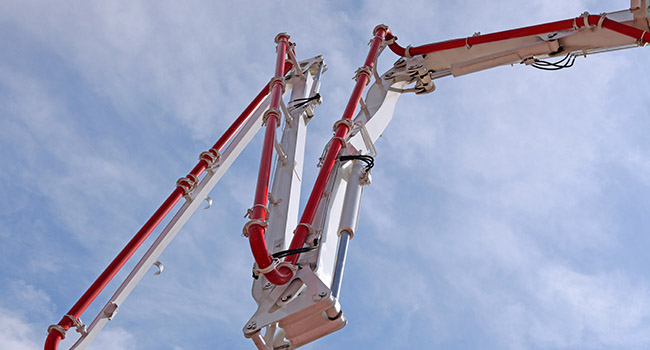
Proportioning, mixing, and placing pumice concrete is similar to that of standard concrete, with a couple of key differences.
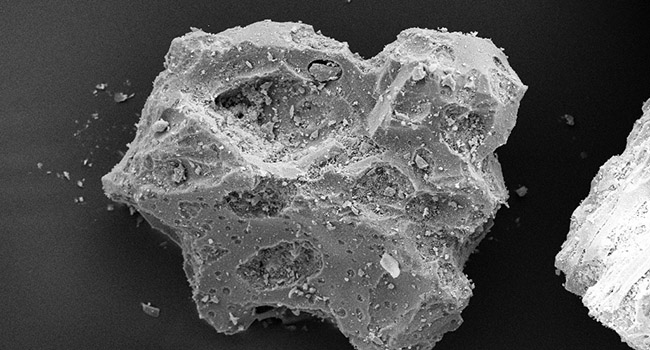
This micrograph of a particle of pumice sand clearly shows the amorphous, foamed stone nature of pumice. It is this inherent structure—even in the pumice sand grains—that imparts the lightweight and insulative characteristics to pumice aggregate.
PUMICE CONCRETE[01] is composed of Portland cement, pumice rock, pumice sand, pumice pozzolan and water. Compared to standard concrete, pumice concrete offers roughly a one-third reduction in weight. Proportioning, mixing and placing are done in a similar manner to that of standard concrete. Pumice concrete is placed and finished with typical concrete equipment and tools and is used, with one exception, for the same applications as sand-and-gravel concrete. That exception: due to the nature of pumice aggregate and sand, pumice concrete takes much more effort and patience to work to a standard surface finish, and for that reason is rarely used for extensive flatwork. But for any and all applications where pumice concrete is vibrated into forms, it presents no placement challenges beyond standard concrete and actually presents several advantages.
PROCESS ADVANTAGES
Of significant note, lightweight pumice concrete can be handled in larger volumes by lighter-duty equipment with less wear and tear on that equipment, and there is a significant reduction of dead weight on supports and formwork. Additionally, the unique lightweight quality of pumice concrete contributes to a decrease in structural steel costs, equipment and form demands, and, consequently, job costs. Also, pumice concrete has superior resistance to harsh weather conditions like freezing and thawing and an R-value some 4-times that of ordinary sand and gravel concrete—making pumice concrete ideal for colder climates and locations that experience dramatic fluctuations in the weather and temperature.
It is the use of pumice aggregate and sand that provide the lightweight advantages of pumice concrete by reducing the dead load on structural supports, trusses, girders and slabs. Pumice is a porous, naturally-occuring volcanic glass, riven with air-filled vesicles formed by the expansion of trapped gasses when the molten lava is expelled into the air and flash-cools. It is this amorphous, cell-filled nature of each stone that give pumice its lightweight and insulative characteristics. Pumice is also an inert material and therefore will not react with the reinforcing steel or any other concrete component.
As for how well pumice compliments Portland cement, pumice has no cementitious properties of its own, yet in the presence of hydraulic lime cement and water, pumice becomes chemically active within the concrete paste and functions as a supplementary cementing material, supercharging the process that forms Calcium Silicate Hydrate (C-S-H), the binding compound that makes concrete concrete, resulting in a stronger, denser concrete matrix. Durability increases because porosity is significantly reduced, and with that reduction come the benefits—resistance to moisture infiltration and subsequent freeze-thaw damage, resistance to destructive sulfate and chloride attacks, and mitigation of efflorescence staining.
CURED PERFORMANCE ADVANTAGES
Lightweight insulating concrete is also notable for dampening sound transmission, for elasticity that reduces brittleness under earthquake conditions, for not spalling under exposure to direct flame, and for mitigating or eliminating moisture condensation on walls and ceilings.
01—The term “pumice concrete” is not to be confused with “pumice-crete.” Pumice-Crete® is a brand-name building material using a specific formulation of pumice and portland cement for a specific proceess and cured product outcome.
Pumice Concrete in Insulated Concrete Forms
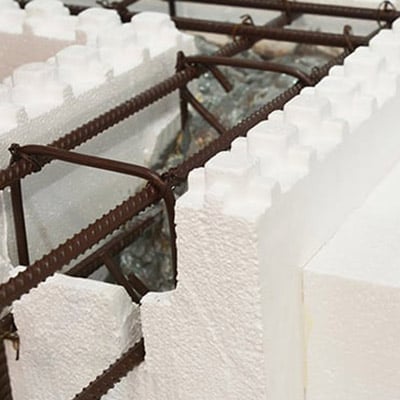
Insulated Concrete Forms (ICFs) were developed to combine the enduring strength of concrete with EPS foam insulation for an expedited wall and decking system construction solution. ICFs provide the shaping, structural form for the concrete and then are left in place to provide remarkable insulation value. Pumice concrete provides an exceptional fit for ICF construction by:
1) Boosting the overall R-value of the wall or deck by adding its 4X R-value advantage over standard concrete to the building envelope.
2) Lightening the deadweight load of concrete on the ICF forms. This means less prep work is needed to prevent blow outs, brace walls, and support floor and ceiling decks.
Properties of Hess Pumice Aggregates
A look at the pumice aggregates properties per ASTM-standards testing (download below). Also tabled is grading data for the pumice aggregates (per ASTM C330) used in concrete.
Download a PDF with data on the Properties of Hess Pumice Aggregates.
Preparation, Mixing, and Placing Pumice Concrete
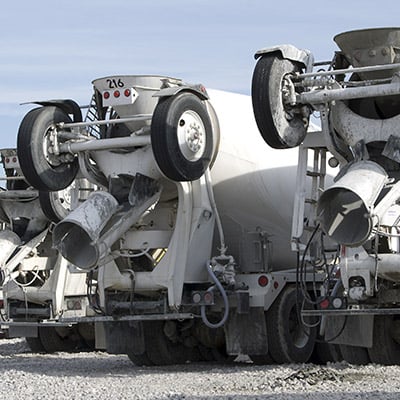
The pumice aggregate should be uniformly prewet to reach total saturation, then allowed to sit until excess water drains out. This will fill the natural internal voids in the aggregate with water. Why? Prewetting will prevent drying out on the way to the placement site and slump will be uniform throughout the load as well as from load to load. Pumice concrete also pumps better when the aggregate and sand is prewet.
An alternative to prewetting the aggregate stockpiles, the pumice and about three-fourths of the mix water can be charged into the mixer and slowly agitated for about 10 minutes before adding the remaining ingredients.
Although handling pumice concrete is similar to normal-weight concrete, pumice concrete has about two inches less slump for the same consistency and workability. It will flow when vibrated and can be finished sooner, however, avoid over-vibrating and overfinishing pumice concrete, as this will tend to float the light coarse pumice particles to the top—not the paste, as with standard concrete.
Cure with the same methods as conventional concrete. Delay form removal for an additional 24 hours when sharp corners have been formed, as they tend to be softer for a few additional days.
Download a PDF with Instructions for Mixing and Placing Pumice Concrete.
Pumice Concrete Mix Designs
The right concrete mix design is influenced by a host of job-specific variables. Hess Pumice does not have a concrete engineer on staff and does not provide custom mix designs, but we have assembled a handful of designs (linked below) that can serve as a reference and starting point.
Download a PDF with data on base Pumice Concrete Mix Designs.
LINKED RESOURCES
—Download PDF: Instructions for Mixing and Placing Pumice Concrete.
—Download PDF: Pumice Concrete Mix Designs.
—Download PDF: Properties of Hess Pumice Aggregates.
—Download PDF: Pumice Aggregates for Internal Water Curing, a research paper from the National Institute of Standards and Technology (U.S. Department of Commerce).
—Website: Using foamed-stone aggregates for thermal resistant concrete.

